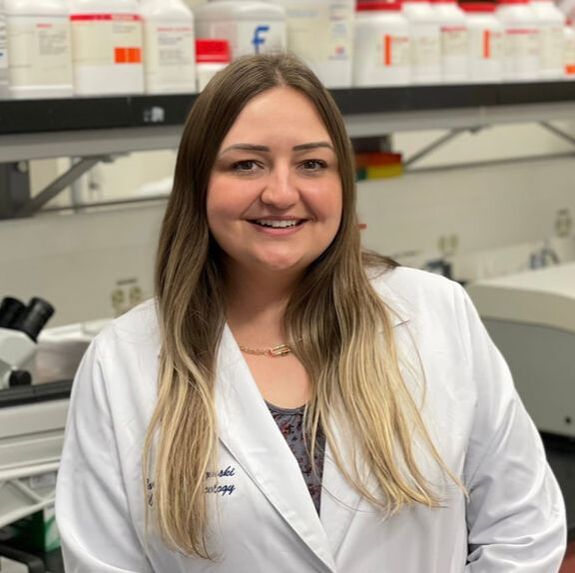| As a post-doctoral fellow in the laboratory of Dr. Frank Porreca, my research has focused on studying orofacial pain. My approach has been to use pharmacology, genetics and animal behavior. My professional goal is to establish a research program that focuses on the exploration of neural, immune and hormonal mechanisms that promote migraine pathophysiology disproportionally in women and to uncover mechanisms that can be exploited for the development of new therapies that will help patients suffering from this debilitating and often chronic condition. Migraine is a common, disabling neurological disorder with a strong genetic component that impairs patients’ quality of life. Currently available therapies are effective in less than half of people with migraine. During my post-doctoral period, I have published several studies on preclinical assessment of migraine and other underlying headache and craniofacial pain disorders with a goal of understanding mechanisms that may promote pain. One of the problems with preclinical studies of migraine is that we cannot replicate the genetic basis that underlies the human condition. For this reason, surrogate strategies have to be used to model the disorder mechanistically. I recently developed an injury-free model of migraine-like pain by evaluating the effect of inhalational exposure of umbellulone, an agonist at TRPA1 receptors that are found on afferent fibers innervating the cranial meninges. Umbellulone is the major volatile constituent of Umbellularia californica, commonly known as the “headache tree”. Anecdotal reports reveal that people with underlying primary headache disorders can develop migraine and cluster headache when exposed to the tree, likely from this volatile substance. Importantly, however, people without headache disorders do not experience headache attacks with umbellulone suggesting a requirement for pre-existing vulnerability. I approached this by subjecting mice to repeated episodes of stress, another known trigger of migraine, to induce vulnerability. Repeated episodes of stress induced a “sensitized” state in mice so that a normally subthreshold stimulus, i.e., umbellulone, now produced pain behaviors that were reminiscent of migraine-like pain. I then used this model to study possible mechanisms relevant to migraine and to investigate new anti-migraine therapies. Using this model, I found that activation of the protease activated receptor 2 (PAR2) receptor could produce migraine-like pain in vulnerable animals and that systemic administration of a monoclonal PAR2 antibody could be an effective preventive migraine therapy. I am currently working with a major pharmaceutical company in their efforts to perform a clinical trial in migraine patients with this antibody. Currently, I have been using genetically modified mice, CRISPR/Cas9 gene editing as well as opto- and chemogenetic methods to explore the peripheral and central neural circuits that can promote migraine pain and that might contribute to the sexually dimorphic nature of migraine. I have also focused on understanding of the neurobiology of the different phases of migraine, including especially the premonitory phase, which appears to be the critical period in which the pain attack begins and represents the transition point from the interictal phase. Finding ways to extend the duration of the interictal phase would allow us to prevent the transition of episodic migraine to chronic migraine. These experiences have led me to improve as a scholar and to become competitive for research funding. I had the honor of receiving my first competitive extramural grant as a principal investigator in 2019. This year, I was delighted to receive an Honorable Mention from the review committee of University of Arizona Postdoctoral Affairs, as one of four finalists for the 2021 Outstanding Postdoctoral Scholar Award. The recognition and my collective experiences will increase my confidence in competing for future grants, aiding my transition to independent status as my career progresses. My goal is to pursue studies of high significance that will be impactful in helping the overall efforts of the headache research community to improve therapy for patients with migraine, post-traumatic headache and other craniofacial pain disorders.As a post-doctoral fellow in the laboratory of Dr. Frank Porreca, my research has focused on studying orofacial pain. My approach has been to use pharmacology, genetics and animal behavior. My professional goal is to establish a research program that focuses on the exploration of neural, immune and hormonal mechanisms that promote migraine pathophysiology disproportionally in women and to uncover mechanisms that can be exploited for the development of new therapies that will help patients suffering from this debilitating and often chronic condition. Migraine is a common, disabling neurological disorder with a strong genetic component that impairs patients’ quality of life. Currently available therapies are effective in less than half of people with migraine. During my post-doctoral period, I have published several studies on preclinical assessment of migraine and other underlying headache and craniofacial pain disorders with a goal of understanding mechanisms that may promote pain. One of the problems with preclinical studies of migraine is that we cannot replicate the genetic basis that underlies the human condition. For this reason, surrogate strategies have to be used to model the disorder mechanistically. I recently developed an injury-free model of migraine-like pain by evaluating the effect of inhalational exposure of umbellulone, an agonist at TRPA1 receptors that are found on afferent fibers innervating the cranial meninges. Umbellulone is the major volatile constituent of Umbellularia californica, commonly known as the “headache tree”. Anecdotal reports reveal that people with underlying primary headache disorders can develop migraine and cluster headache when exposed to the tree, likely from this volatile substance. Importantly, however, people without headache disorders do not experience headache attacks with umbellulone suggesting a requirement for pre-existing vulnerability. I approached this by subjecting mice to repeated episodes of stress, another known trigger of migraine, to induce vulnerability. Repeated episodes of stress induced a “sensitized” state in mice so that a normally subthreshold stimulus, i.e., umbellulone, now produced pain behaviors that were reminiscent of migraine-like pain. I then used this model to study possible mechanisms relevant to migraine and to investigate new anti-migraine therapies. Using this model, I found that activation of the protease activated receptor 2 (PAR2) receptor could produce migraine-like pain in vulnerable animals and that systemic administration of a monoclonal PAR2 antibody could be an effective preventive migraine therapy. I am currently working with a major pharmaceutical company in their efforts to perform a clinical trial in migraine patients with this antibody. Currently, I have been using genetically modified mice, CRISPR/Cas9 gene editing as well as opto- and chemogenetic methods to explore the peripheral and central neural circuits that can promote migraine pain and that might contribute to the sexually dimorphic nature of migraine. I have also focused on understanding of the neurobiology of the different phases of migraine, including especially the premonitory phase, which appears to be the critical period in which the pain attack begins and represents the transition point from the interictal phase. Finding ways to extend the duration of the interictal phase would allow us to prevent the transition of episodic migraine to chronic migraine. These experiences have led me to improve as a scholar and to become competitive for research funding. I had the honor of receiving my first competitive extramural grant as a principal investigator in 2019. This year, I was delighted to receive an Honorable Mention from the review committee of University of Arizona Postdoctoral Affairs, as one of four finalists for the 2021 Outstanding Postdoctoral Scholar Award. The recognition and my collective experiences will increase my confidence in competing for future grants, aiding my transition to independent status as my career progresses. My goal is to pursue studies of high significance that will be impactful in helping the overall efforts of the headache research community to improve therapy for patients with migraine, post-traumatic headache and other craniofacial pain disorders. |
|
0 Comments
|
SpotlightEach month we'll feature a Postdoctoral Scholar and their research, sharing their experiences from the UA, life in Arizona and their research interests. Archives
November 2022
Categories |


 RSS Feed
RSS Feed
